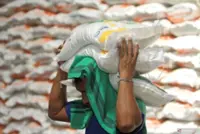
The dissemination workshop on the results of the 2014 national accounts base year update, held at the Sokha Hotel on July 2. - Photo: The Phnom Penh Post/ANN
PHNOM PENH: Cambodia has officially updated its national accounts base year from 2000 to 2014, an important step in ensuring the accuracy of its economic statistics and providing a clearer picture of the country's economic landscape.
The change was announced at a dissemination workshop attended by key government officials, international organisations and economic experts at the Sohka Hotel on Tuesday (July 2).
In his opening speech, Minister of Planning Bin Trachhey emphasised the update’s importance in ensuring the reliability of the country’s economic data.
He noted that, previously, the calculation of gross domestic product (GDP) was based on the year 2000 as a reference point.
"The calculation of GDP [has been] grounded in the base year 2000, which covers 20 years up to 2022," Trachhey stated.
"This update aligns with international standards and incorporates comprehensive data sources, providing a more accurate representation of our economy."
He said according to the UN Guidelines on the System of National Accounts (UN-SNA), it is recommended to change the base year every five to 10 years to better reflect economic growth, size and structure.
The new base year utilises data from several key surveys and censuses, including the 2011 economic census, 2013 agricultural census, 2014 mid-census survey and 2014 socio-economic survey.
Administrative data sources such as government financial statistics from the Ministry of Economy and Finance, international trade data from the General Department of Customs and Excise (GDCE) and data from other ministries and institutions were also incorporated.
International stakeholders taking part in the initiative include the International Monetary Fund (IMF), the UN Economic and Social Commission for Asia and the Pacific (UNESCAP) and the Swedish International Development Cooperation Agency (SIDA).
Try Rithea, director-general of the planning ministry’s National Institute of Statistics (NIS), explained that the updated base year reflects changes in the economy's size, scope and structure.
"The 2014 base year is based on the '2008 National Accounting Statistics System' and the 'International Standard Industrial Classification of All Economic Activities [ISIC 4]’, which replaced the outdated ISIC 3 and the 1993 National Accounting System," he said.
Economic growth and structural changes
“With the new base year, Cambodia's 2022 GDP has been recalculated to 160.1 trillion riel (approximately US$39.5 billion), showing a 5.1% increase,” said Trachhey, adding that, “the GDP per capita now stands at US$2,345”.
He said for 2014, economic size was recalculated to 88.9 trillion riel ($22.1 billion), an increase of 31.9% compared to the old base year.
He noted that after the update, GDP increased by 42% (up from 40%) in 2014 compared to 2000 and per capita income increased from $1,131 to $1,489 during the same period, after the adjustment.
According to Rithea, the sectoral composition of the economy has also shifted, with the agriculture’s share of GDP down from 29% to 22%, while the industry sector’s share increased from 26% to 30% and services from 40% to 42%.
“The NIS has been preparing a three-year roadmap for 2024 [2024-2026] in accordance with the recommendations of the head of the Royal Government,” said Rithea.
He said this shift highlights the growing importance of the industrial and service sectors in the country’s economy.
Ung Luyna, director-general of the finance ministry’s General Department of Policy, noted the updated GDP figures are more reflective of the actual size and structure of the economy.
"Non-garment manufacturing, trading, hotels and restaurants, real estate and other services remain significant contributors, with minor variations in their contributions over the years," he said.
Future plans and policy implications
Looking ahead, the NIS is preparing for the next change in 2026, to base year 2024.
This preparation will involve close cooperation with the finance ministry, the National Bank of Cambodia (NBC), other ministries and institutions and educational and research bodies.
"The results of the change to base year 2024 will be even better, reflecting our continuous efforts to improve data quality," said Trachhey.
According to Luyna, the updated data will enhance the formulation of economic policies and interventions, aligning with the Industrial Development Policy 2015-2025 and aiding in socio-economic development planning.
Challenges and disadvantages
Luyna said that Cambodia's shift to a new GDP base year has brought both opportunities and challenges.
He noted that as the country transitions from Least Developed Countries (LDC) status, it faces the risk of losing preferential benefits that have supported its economic growth.
“This includes access to concessional and high concessional loans, which are crucial for financing our development projects,” said Luyna.
Moreover, losing preferential market access could increase tariffs and trade barriers, impacting the competitiveness of Cambodian products internationally, he said.
“The elimination of preferential tariffs and other special treatments could further strain our export sector,” he added.
Luyna noted the new base year reveals a higher debt-to-GDP ratio, highlighting future financial risks.
He stressed that close monitoring of private debt trends among enterprises and households is necessary.
Strengthening financial oversight and improving financial literacy among the population are crucial steps to mitigate these risks, he added.
According to Luyna, the industrial sector requires careful planning to promote industries beyond garments, including fostering diversification and supporting the processing industry.
He mentioned that the service sector, particularly tourism, needs ongoing investment and policy support for sustained growth and recovery.
“Our external trade remains a concern, with exports still low compared to regional averages.
"This large current account deficit requires ongoing efforts to diversify both imports and exports, promote human capital and strengthen trade policies,” he said.
“Import diversification is particularly challenging, as it involves finding new trade partners and securing stable supply chains,” he added. - The Phnom Penh Post/ANN










































